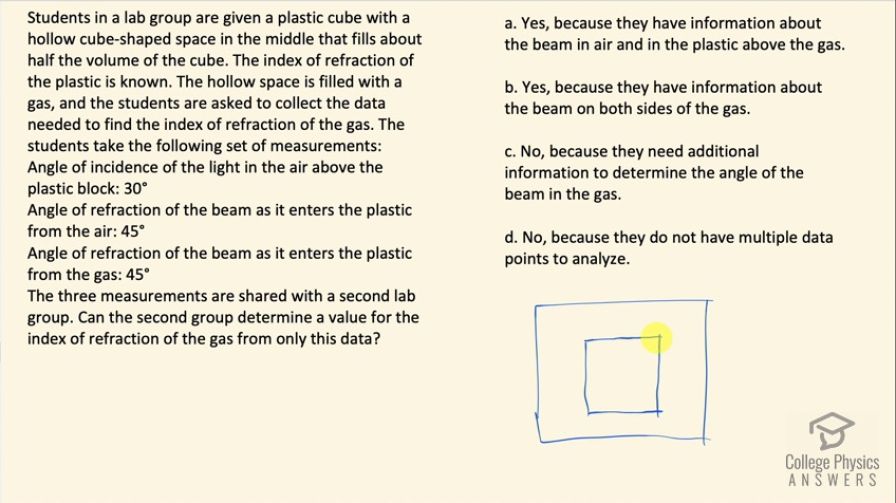Question
Students in a lab group are given a plastic cube with a hollow cube-shaped space in the middle that fills about half the volume of the cube. The index of refraction of the plastic is known. The hollow space is filled with a gas, and the students are asked to collect the data needed to find the index of refraction of the gas. The students take the following set of measurements:
- Angle of incidence of the light in the air above the plastic block: 30°
- Angle of refraction of the beam as it enters the plastic from the air: 45°
- Angle of refraction of the beam as it enters the plastic from the gas: 45°
- Yes, because they have information about the beam in air and in the plastic above the gas.
- Yes, because they have information about the beam on both sides of the gas.
- No, because they need additional information to determine the angle of the beam in the gas.
- No, because they do not have multiple data points to analyze.
Final Answer
(c)
Solution video
OpenStax College Physics for AP® Courses, Chapter 25, Problem 8 (Test Prep for AP® Courses)

vote with a rating of
votes with an average rating of
.
Video Transcript
This is College Physics Answers with Shaun Dychko. The students in a lab have some information about this plastic cube that's quite thick and it has this interior that's filled with some gas with an unknown index of refraction and so index of refraction of the gas is unknown; the index of refraction of the plastic is known and the index of refraction of air is approximately 1 and they do some measurements and so they have the angle of incidence of the light in the air above the plastic block and so that would be... this is the light ray then they know Θ 1 they know the angle of refraction of the beam as it enters the plastic from the air and so that would be... so this is 30 here by the way... and so it's going to bend away from the normal and so we have Θ 2 is 45 degrees and then it enters this gas, bends in some way that we don't know and then once it exits the gas, we know that it has an angle that is again 45 degrees but the thing is this angle will be 45 degrees no matter what the index of refraction of the gas is so the exit angle here because it's going back into this same medium as it had before it's going to be the same angle as this angle here so we don't have enough information to answer this question because we know nothing about the behavior of the light in the gas itself so the answer to this question is (c).